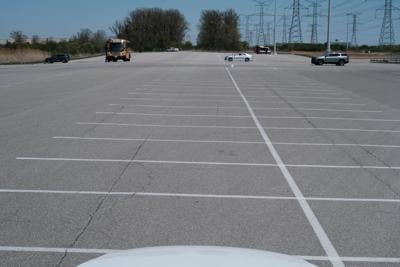The big number
14.4%
the percentage of parking spaces at the 1,881-space TTC parking lot at Pioneer Village station that were used on an average weekday last year.
In addition to trains, tracks and tunnels you’d expect a transit agency to oversee, the TTC also manages a vast expanse of concrete near Jane Street and Steeles Avenue.
When it opened in 2017 to serve the new Pioneer Village subway station, its 1,881 spaces made it one of the biggest in the TTC’s portfolio of commuter parking lots.
But less than a decade later, this vast expanse of concrete has turned out to be a massive, miserable money suck, extracting more than $1 million from the TTC’s budget last year.
And unless something changes, this money suck is poised to start sucking even more.
A report set to be considered by the TTC board this Wednesday shows that on an average weekday the lot was only 14 per cent full, leaving more than 1,600 empty spots collecting dust.
With a fee of seven bucks a day, the parking spaces generated $300,000 in revenue for the TTC last year, nowhere near close to covering the $1.4 million it cost to licence the land from Hydro One — the lot is located under some heavy-duty power lines — and to conduct regular maintenance.
And things could get worse. The landlords at Hydro One have told the TTC they’d like to hike the rent for the Pioneer Village parking lot by 167 per cent, from $900,000 per year to $2.3 million. That puts this patch of concrete on track to lose the TTC $2.5 million annually.
In response, TTC staff are recommending that the board approve a reduction in the number of spaces. By cutting the size of the lot in half, both licence fees to Hydro One and maintenance costs will be reduced. But even at half the size, the lot is still poised to lose nearly $1.3 million per year, unless usage picks up.
There’s reason to doubt it will. Last year, parking lot usage at subway stations recovered to about 67 per cent of pre-pandemic levels, lagging well behind the 77 per cent ridership recovery seen on the subway. And, according to the 2022 edition of the Transportation Tomorrow survey measuring the travel habits of people in the GTA, just two per cent of subway riders park at the TTC’s parking lots.
That means that a chunk of the cost of keeping this vast expanse of concrete is being covered via the fares of the 98 per cent of subway commuters who don’t drive and park. And some of the parking cost is paid for by property taxes, as part of the subsidy º£½ÇÉçÇø¹ÙÍøresidents pay to cover the cost of operating the TTC.
While Pioneer Village, so vast and so empty, is one of the worst money losers in the TTC’s parking portfolio, it’s hardly the only one. By percentage, usage is even worse at nearby Finch West subway station, where a much smaller lot with 329 spaces is used by only about 25 cars on the average weekday — an eight per cent utilization rate.
Parking lots at Don Mills station and Warden station also fare poorly, with 18 per cent and 28 per cent weekday usage rates, respectively. Overall, only eight of the 23 parking lots meet the TTC’s recommended target of 85 per cent full on an average weekday.
As a result, the TTC made just $7.7 million in parking revenue versus $12.6 million in direct parking costs in 2024 — a net loss of $4.9 million.
The transit agency does calculate that some of their lots can be considered profitable if you factor in the fares paid by riders who park, but there’s also a potential opportunity cost. Could that $4.9 million generate more ridership if it were spent on service improvements, instead of parking subsidies? It’s worth considering.
But, while the report to the TTC board includes some sensible recommendations for change, the appetite for major change appears limited.
For instance, the TTC acknowledges that its parking rates, averaging $5.71 per day, are way lower than the rates charged for nearby Green P lots, which charge more than $15 on average. But the report only proposes increases that will see the daily rate increase to a maximum of eight bucks a day.
And while the TTC deserves credit for offering up some of its developable parking lots to housing projects with affordable units over the past few years, the process could be more aggressive. Compared to money-losing parking lots, adding new residents adjacent to subway stations should be a much more cost-effective way to generate new transit ridership.
The timid approach means the TTC is proposing a parking program that will still lose $1.4 million in 2026 and isn’t projected to break even until after 2031. Even in the far-flung days of 2041, the parking lots are not projected to make a significant profit, preventing any real opportunity for parking revenue to pay for better transit service. It sets the stage for a frustrating future where transit riders will see crowded trains and empty parking lots.





























To join the conversation set a first and last name in your user profile.
Sign in or register for free to join the Conversation